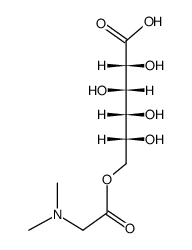| Description |
Vitamin B15 (Pangamic Acid) is a natural, ubiquitously in plant seeds substance and can used be as an agent stimulating cellular respiration. Vitamin B15 contains D-gluconodimethyl amino acetic acid. Vitamin B15 is also a immune-correcting agent[1][2]. Vitamin B15 can be used for wide range of diseases.
|
| Related Catalog |
|
| In Vitro |
Unequivocal reports on identity and functions of Vitamin B15 (Pangamic Acid) in the literature make it impossible, however, to accurately assess either its chemical identity or its biological or medical functions. Indeed, the chemical identity of genuine Vitamin B15 (Pangamic Acid) has apparently never been ascertained or verifiably chemically identified as being the molecular weight 281-ester of DMG and gluconic acid claimed by Krebs and some Russian authors, and there is considerable doubt that such a stable substance exists with the straight chain sugar gluconic acid. Vitamin B15 (Pangamic Acid) is identified as a substance most likely containing both a sugar and a dimethylamine group[1].
|
| In Vivo |
Addition of Vitamin B15 (Pangamic Acid) to the diet (Wistar rats; 2.5 mg/100 g of diet) increases the degree of fatty infiltration of the liver which is maintained at a stable level throughout the whole experiment, i.e. 12-18 months[1][3]. Vitamin B15 (Pangamic Acid) enriches in the rat diet reduced glutathione peroxidase (after one year) and also glutathione transferase (after 18 months) in the brains of the animals, thus impairing their antioxidative capacities[1]. Vitamin B15 (Pangamic Acid) treatment increase the cytochrome oxidase- and also succinate dehydrogenase-activity in certain rat tissues[1].
|
| References |
[1]. Schneider D, et al. Studies on the chemical identity and biological functions of pangamic acid. Arzneimittelforschung. 1999 Apr;49(4):335-43. [2]. Zemskov AM, et al. Typical immune system responses to differential monotherapy with immune-correcting drugs. Fiziol Cheloveka. 2001 Jul-Aug;27(4):97-103. [3]. Ziemlański S, et al. Effect of long-term diet enrichment with selenium, vitamin E and vitamin B15 on the degree of fatty infiltration of the liver. Acta Physiol Pol. 1984 Jul-Aug;35(4):382-97. [4]. Vitamin B15
|
